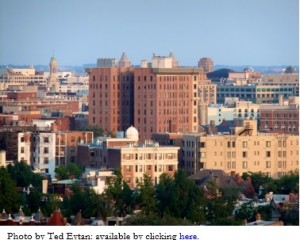An opportunity is coming this fall to improve a DC program that creates affordable housing in new market-rate developments. The Zoning Commission will consider recommendations to modify the Inclusionary Zoning (IZ) program to produce more low-cost housing and at prices affordable to more DC households. We hope the Commission will take assertive steps to enable this important program to better meet DC’s growing affordable housing needs.
Inclusionary zoning harnesses DC’s strong housing market to create low-cost units in market-rate apartment and condo developments throughout the city. It works by allowing new residential buildings to be larger than normally allowed by zoning rules. In return for the extra square footage (called “bonus density”), up to 10 percent of the building is set aside as affordable housing.
IZ has many positive benefits. It creates low-cost housing in high-cost neighborhoods, where access to public transportation, good schools, retail amenities, and job opportunities are likely to be best. And it does so without requiring tax dollars. About 770 IZ units have been built or will soon be coming on line, with hundreds more planned, and the number will grow given record-high levels of building permits in recent years.
But there are ways to ensure that Inclusionary Zoning does as much as possible to address DC’s growing housing needs.
- Ensure IZ serves the low income families who need it most. Due to its current design, fewer than 1 of 5 IZ units have gone to residents with incomes below 50 percent of the median for the metropolitan area, or $49,150 for a family of three. The rest are affordable to households at 80 percent of area median income, or $61,200 for a family of three. Yet the families most likely to struggle to afford housing in DC are at the lower income level.
An advocacy campaign, of which DCFPI is a part, hopes that half of all future IZ units will be affordable to families earning below $49,150. A preliminary report by the Bowser administration to the Zoning Commission agreed that IZ should better serve low-income residents. Several Zoning Commission members have asked the administration to look into even stronger affordability scenarios. A DC Council resolution passed this year also calls for strengthening IZ’s affordability.
- Get more affordable units out of each IZ project. Setting aside a greater portion of IZ buildings will increase the number of affordable units the program produces. This may mean allowing buildings to be larger or denser, so that the low rents of IZ units are balanced by more market-rate space. Members of the Zoning Commission have asked the Bowser administration to examine how that could work given other zoning rules, and we hope all parties come up with a solution that gets as much affordable housing out of IZ as possible.
With encouraging signs from many interested parties, we are hopeful that in the future IZ will produce more affordable units that low income families sorely need in DC’s high-cost market.
To print a copy of today’s blog, click here.

